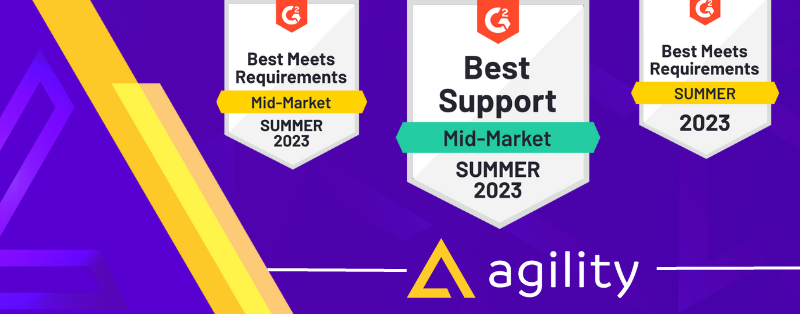Your website is a critical component of your marketing operations.
Everything you do—the content you create, the ads you run, your link-building and PR efforts—is in fact, geared towards convincing your potential customers to visit your website and complete a specific action, whether it's signing up or buying any of your products.
As your potential customers look for information about their problems and their solutions, your website will feature prominently in their buying journey. So you’ll need to be proactive about delivering a better buying experience by modernizing your website.
In this article, we'll discuss four proven ways to modernize your website to improve its performance and help you achieve your business objectives.
What is website modernization?
Website modernization is the process of improving different elements of your website to deliver a great buying experience.
To modernize your website, you’ll need to collect data that helps you understand who your customers are and how they interact with your website. It may come from your analytics reports, visitor tracking reports, and customer surveys, showing you common hurdles that web visitors have to jump over when using your website.
In addition to identifying the hurdles that get in the way of delivering a great buying experience, you will also understand what your potential customers expect when interacting with your website. When modernizing your website, you may decide to make a few changes to some elements to eliminate the hurdles that get in the way of delivering a better buying experience.
Alternatively, you may decide to redesign your entire website with new and better elements that go above and beyond what your potential customers expect.
That said, how often should you modernize your website? The evolution of customer expectations and different social events shape how buyers view their digital buying experiences as new trends are always emerging.
Some don’t last long, but others such as inclusivity mean that you will want to change different elements of your website to reflect that and appeal to a diverse group of buyers.
There is also the emergence of new technology to improve marketing and content operations with better functionality and more features. Modernizing your website would mean adopting these tools which promise to help you deliver better buying experiences.
Considering that the emergence of new technology and new trends aren’t static, there’s no definite answer to your current website’s shelf life. However, if you’re not achieving your business objectives and you realize that your website is the weak link, then you need to modernize it.
4 Ways to modernize your website
Each element on your website, such as your content, design, fonts, and content management system matters. These elements complement your marketing strategy at each stage of the buying journey. When you’re looking to modernize your website, here are four strategies that will guarantee a better buying experience for your buyers.
1. Use a headless CMS
There are different tools to collect data on customer behavior on different channels. This in turn provides different types of insights.
Take the rise of omnichannel shopping for example. Buyers use different channels to connect with your brand, and they expect a consistent experience across different touchpoints.
Yet, a report by Salesforce reveals that 60% of customers don’t think companies present a unified buying experience. They report that they feel “like they’re communicating with separate departments, not one company.”
To deliver a unified buying experience, consider moving away from traditional CMS tools. Instead, use a headless CMS to deploy content to any channel.
Traditional CMS tools have a monolithic site architecture. This means that all components are interlinked and dependent on each other. If a single component fails, then other parts of the site will be affected or the site may crash. As a result, you can’t always count on it to deploy content.
Besides, it's not scalable to rely on traditional CMS tools. As your needs grow, you’ll need to update the tool or introduce integrations to improve content governance. That means you’ll deal with a growing codebase. In turn, this will be harder to manage—updating one function of your CMS can put other functions at risk, especially if they rely on the same line of code to work efficiently.
A headless CMS, on the other hand, comes with a microservices architecture. Microservices communicate with each other, but they don't rely on each other to work. So, if you want to change or update one microservice, you can do it without affecting the functionality of other services.
You can also take advantage of available third-party applications that will help you deliver better customer buying experiences across different channels. They’ll help you scale individual services without affecting the functionality of other microservices.
2. Improve your messaging strategy
Your messaging strategy shapes the tone and style you use in your content. It is more effective at improving your conversion rates when it aligns and resonates with your web visitors.
But let's admit it. Improving your conversion rate by changing the header image, button color, and font type is barely scratching the surface. If you’re not continually working to improve your messaging strategy to create better copy, you’ll have a difficult time convincing your web visitors to sign up or pay for your products.
Here are a few concrete steps you can take to improve your messaging strategy:
- Improve your USP by making sure it states who your target audience is and addresses a pain point that your customers have. Narrow down to your specific audience segments to make sure that you’re not serving everyone.
- Make your USP credible by showing how you’ve delivered results for customers in the past. Use testimonials, show company logos from companies you’ve worked with, and if possible, include some numbers in the results you’ve delivered.
- Depending on the industry you’re in, show credentials that prove your expertise and trust badges that prove your credibility. Since your customers evolve over time, their expectations, challenges, and needs will equally evolve.
- Continually conduct research and interview customers to update your inbound marketing persona to reflect their new behaviors, challenges, and mindsets. This will guide your copy to make sure it resonates with them in the tone you use, the style you choose to communicate in, and the emotions your copy evokes. Besides, customer interviews help you identify how you can set yourself apart from your competition.
3. Embrace inclusive and engaging designs
Your business serves different types of customers, and you need to adapt your design to reflect that.
Besides, recent events have triggered ongoing conversations around diversity, equality, and inclusivity. This has opened up a push for inclusivity in the workplace.
Since your buyers are part of the society in which these events and conversations happen, they expect the businesses they deal with to take the lead by hiring an inclusive workforce. For the most part, companies are transparent about it. Take this further by embracing inclusive designs in your visual content to appeal to a wider audience and reflect your diverse customer base.
Your visuals should represent customers from different racial backgrounds, gender identities, ages, and socioeconomic backgrounds.
In addition to inclusivity, consider using engaging designs with bold backgrounds to make your text stand out. Use colorful icons that create contrast and keep your web visitors engaged. When visualizing data, consider creating simpler visual designs that make it easy to communicate with your audience and help them understand what you’re talking about.
4. Improve accessibility and usability
When potential customers arrive on your website, they want to find what they need without spending too much time and energy looking for it. That means you’ll need to make sure that your website is accessible and easy to use so that your visitors find what they need.
Besides, when faced with a task that requires us to invest our time and energy, our ingrained nature will always lean towards the path of least resistance to get things done. So, make sure that your site’s navigation is simple and straightforward, such that your visitors find what they need with a few clicks.
Take a look at your user flow reports from Google Analytics to see how your web visitors interact with your website to see what pages they visit often and make sure they’re easily accessible.
If you’re creating video content, then you’ll want to make your videos accessible to everyone (including people with disabilities) by including captions.
Getting it right with website modernization
Whether you choose to modernize your entire website or improve a just few elements on your website, any improvement you make will always advance your website’s performance and, by extension, your brand perception.
To get started with modernizing your website, look at what your data tells you about how your web visitors behave on your website. Keep an eye on any trends that are constantly shaping digital experiences to help you choose what elements to improve. We recommend checking out a headless CMS like Agility CMS to collect customer data and keep up with these trends and deliver the best possible customer experience.
Lastly, website modernization is not a one-time event. It is a continuous process that requires you to constantly engage with your customers to know what they expect and improve your website to meet these needs.
If you’re ready to use Agility CMS to upgrade your website, try a demo today.




